Did you know that nearly 70% of off-road vehicle owners report experiencing issues within the first two years of ownership?
This staggering statistic highlights the importance of understanding the common problems associated with the Kawasaki KRX 1000.
As someone who has spent considerable time researching and driving this model, I’ve discovered that while it’s an impressive machine, it’s not without its challenges.
Here we will explore the 10 major Kawasaki KRX 1000 problems reported by its owner and provide the solutions in a way that if you are a beginner you will also fix this issue easily.
The most common problems of Kawasaki KRX 1000 are belt issues, starting problems, hard to shift, clutch issues, brake problems, electrical problems, throttle issues, fuel pump failures, engine overheating, engine knocking and engine misfire problems.
Kawasaki KRX 1000 Problems and solutions
Now we are going to explore the most common problems of the Kawasaki KRX 1000 that you might face on offroading.
1. Kawasaki KRX 1000 Belt Problems

In my experience with the Kawasaki KRX 1000, I’ve noticed that belt issues often arise from frequent use in rugged conditions. Continuous high-speed runs can cause excessive wear.
Additionally, improper installation or lack of maintenance contributes significantly to these problems.
The belt operates under intense conditions, so debris and dirt can easily become lodged, causing slippage or damage.
Also explore the Kawasaki Concours 1000 Problems
Identifying Symptoms of Belt Issues
If you suspect belt problems in your KRX 1000, you may notice some warning signs.
Common symptoms include unusual noises, such as grinding or squeaking sounds, which indicate wear.
Another clear sign is a sudden drop in performance. If your vehicle hesitates or has difficulty accelerating, it’s wise to check the belt right away.
I’ve encountered these issues myself and quickly learned the importance of early detection.
Solutions
To remedy belt problems in your Kawasaki KRX ATVs, regular maintenance is key.
Make it a habit to inspect the belt for wear every few rides, especially if you frequent off-road terrains.
If you notice significant damage, replacing the belt immediately can save you from more severe engine issues later.
Furthermore, cleaning the clutch area and ensuring the belt is correctly tensioned can prevent further complications.
By following these steps, you can keep your KRX 1000 running smoothly and enjoy your rides without worry!
2. Starting Problems
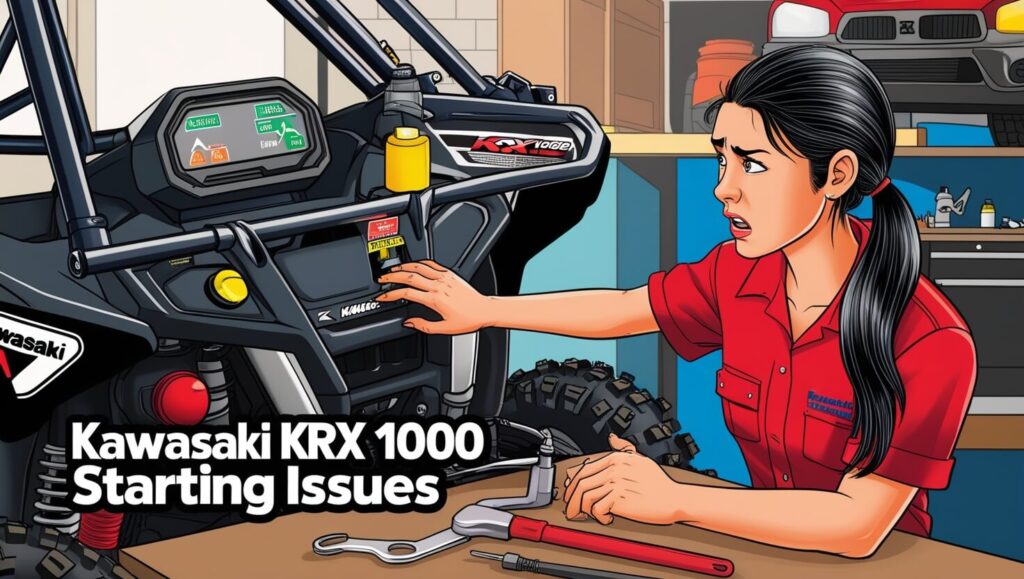
If you own a Kawasaki KRX 1000, you might encounter issues when trying to start your machine.
From my experience, the most frequent cause is a weak battery. If your battery isn’t fully charged, the engine won’t crank properly.
Another possibility is a loose or corroded connection in the wiring. These issues can prevent electricity from flowing smoothly.
Fuel blockage can also lead to starting issues; if your fuel filters are clogged, they can restrict fuel delivery to the engine.
Also explore the Kawasaki Mule Pro MX Problems
Identifying Symptoms of Starting Trouble
Common symptoms include slow cranking, clicking sounds when turning the key, or no response at all. If the lights dim upon attempting to start, that’s a strong indicator of battery issues.
In my case, I noticed the engine cranking sluggishly one morning, which led me to suspect the battery. The more you observe these signs, the easier it’ll be to pinpoint the underlying problem.
Solutions
Once you’ve identified the cause, you can implement a solution. For a weak battery, try jump-starting it or using a trickle charger to restore power.
If connections are loose, check and tighten all connections, and think about cleaning any corrosion. If it’s a fuel problem, replacing fuel filters is often the straightforward answer.
Having dealt with these challenges, I’ve learned a systematic approach can save you a lot of headaches.
Remember, taking the time to understand your Kawasaki KRX 1000 will not only enhance your riding experience but also extend the life of your machine.
3. Hard to Shift
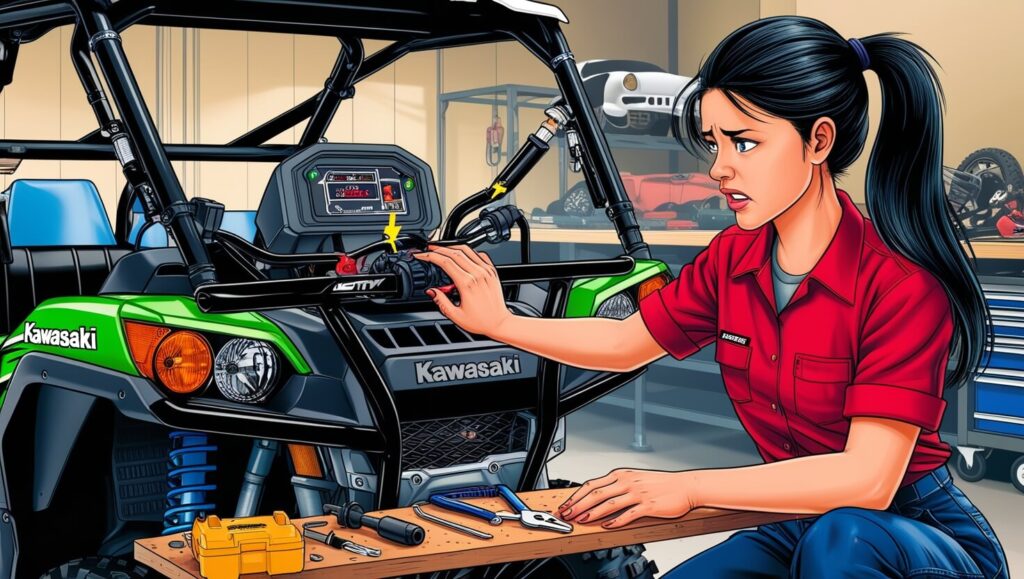
If you own a Kawasaki KRX 1000 and have experienced difficulties while shifting gears, you’re not alone. It’s a common issue that can be attributed to several factors.
One primary cause is the clutch adjustment; if it’s too loose or too tight, it can hinder smooth shifting.
Other potential culprits include low transmission fluid levels and issues with the gear linkage system. In my experience, ensuring proper clutch adjustment has made a significant difference.
Recognizing the Symptoms
You might notice a few symptoms signaling that your KRX 1000 is hard to shift.
These include grinding noises when attempting to shift gears, difficulty engaging the transmission, or a noticeable delay in response.
Additionally, if you feel resistance or hear unusual sounds, it’s essential to pay attention.
These signs not only indicate the need for immediate fixes but can also save your vehicle from more extensive damage in the long run.
Also explore the Kawasaki Mule 3010 Problems
Solutions to Consider
To combat these shifting problems, several solutions can be implemented.
First, check and adjust the clutch according to the manufacturer’s guidelines. Regular maintenance of your transmission fluid is also crucial—ensure it’s at the right level and condition.
If problems persist, inspecting the gear linkage may uncover any misalignments.
Personally, I found that engaging with a certified technician helped identify issues that I didn’t notice, making the repair process smoother.
4. Kawasaki KRX 1000 Clutch Problems
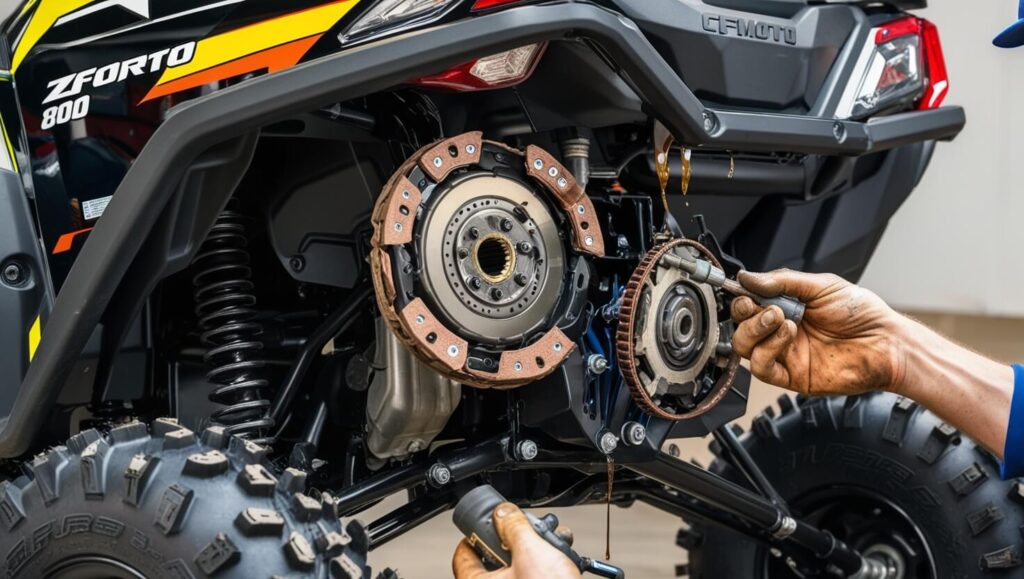
As an avid off-roader and owner of the Kawasaki KRX 1000, you might experience issues with the clutch of your ATV that many other riders face. Understanding these problems can save you time and money.
Common problems include clutch slipping, sticking, and unusual noises. Slipping often occurs when you’re accelerating, which can leave you feeling frustrated and unsure about how to proceed.
Symptoms to Watch For
When your KRX 1000 starts to show signs of clutch issues, take note of the symptoms. If you hear grinding noises or feel a rough engagement, it’s likely something needs your attention.
Additionally, if your engine revs up without a corresponding increase in speed, you might be looking at a slipping clutch. These issues can make the ride less enjoyable, and immediate action is recommended.
Solutions
Firstly, always ensure your clutch cable is properly adjusted; this simple fix can resolve many issues. If you find the clutch sticking, a thorough cleaning and lubrication can work wonders.
In cases where the problem persists, consider replacing your clutch pack, which typically involves removing the clutch cover.
Personal experience taught me that it’s sometimes best to consult a professional if you’re uncomfortable handling the repairs yourself.
Many dealers have experienced technicians who understand these machines inside and out.
Remember, timely maintenance will not only improve your riding experience but can also extend the life of your KRX 1000.
Also explore the Kawasaki Brute Force 750 Problems
5. Brake Problems

Common brake problems typically include unusual noises, decreased braking power, and responsiveness.
It’s essential to understand these issues to ensure safety while driving. One common cause of brake trouble may stem from worn-out brake pads or damaged rotors.
Recognizing Symptoms of Brake Issues
When I first noticed symptoms of brake problems, such as grinding sounds during use or a spongy brake pedal, it was clear I needed to investigate.
You may also observe vibrations or pulling to one side while braking — all indications that your brakes could be failing.
These symptoms signal that it’s time to inspect your brake components and possibly replace them.
Solutions
If you suspect worn brake pads, replacement should be your first step; this can significantly improve your vehicle’s stopping power.
Additionally, ensure that your brake fluid is at the optimal level; low fluid can affect performance. Regular maintenance, including brake inspections, can help prevent issues from escalating.
6. Kawasaki KRX 1000 Electrical Problems
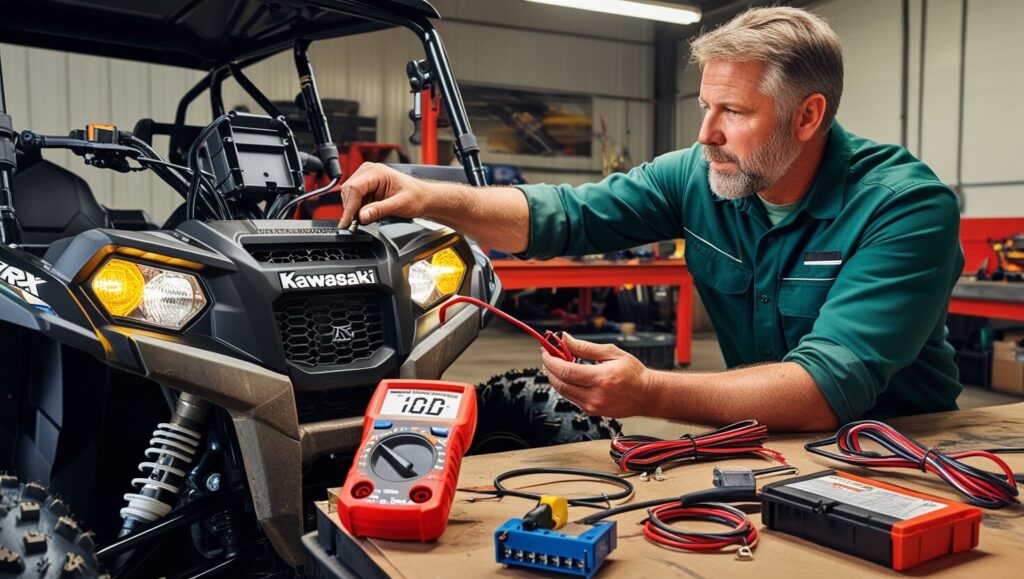
Electrical issues in the Kawasaki KRX 1000 can stem from various sources.
One of the most frequent causes is poor battery connections. Over time, corrosion can build up on the terminals, leading to insufficient power delivery.
Additionally, faulty wiring or loose connections within the electrical system may result in intermittent failures.
I once had a situation where my KRX wouldn’t start, and it turned out to be a loose battery cable!
Identifying Symptoms of Electrical Failures
Symptoms of electrical problems can vary, but a few common indicators include flickering lights, warning lights on the dashboard, or failure to start.
If you notice a sudden drop in power while driving or your winch is not functioning, these may also signal electrical issues. Paying attention to these early warning signs can save you time and prevent further damage.
Solutions
When it comes to resolving these issues, the first step is to check the battery connections and ensure they are clean and tight. If the problem persists, inspecting the wiring for frays or loose connections is essential.
Sometimes, you might need to change the battery. It’s crucial to consult the owner’s manual or seek assistance from a professional if you are unsure.
I learned the hard way that taking quick, preventive action is key to avoiding bigger problems down the road!
7. Throttle Problems
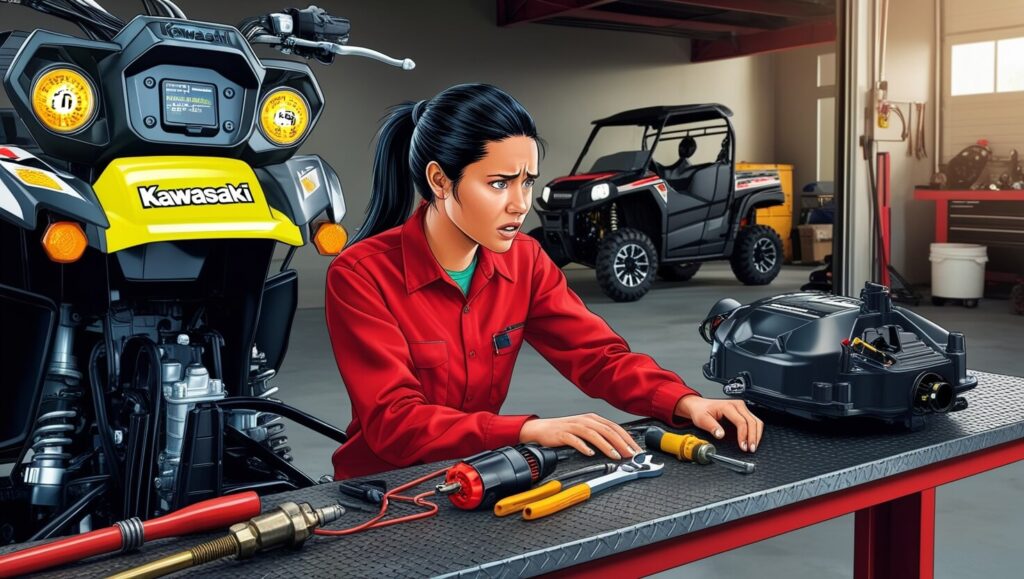
As a Kawasaki KRX 1000 owner, I have encountered some frustrating throttle problems that many of you might relate to.
When the throttle response is sluggish or unresponsive, it can ruin your adventure.
Often, these issues arise from factors such as dirt in the throttle body, a faulty accelerator pedal position sensor, or even problematic wiring connections.
It’s crucial to diagnose these problems early to ensure your ride remains safe and enjoyable.
Identifying Symptoms
You might be wondering how to identify throttle problems in the KRX 1000.
Common symptoms include a sudden loss of power during acceleration, irregular engine revving, or warning lights on your dashboard.
From my experience, a noticeable symptom was a lack of throttle response while I was navigating rough terrains.
Keep an eye out for these signs because they could indicate deeper issues involving your throttle system.
Solutions
First, I recommend checking the throttle body for any buildup of dirt or debris. Cleaning it can improve performance dramatically.
If that doesn’t solve the issue, the next step is to check the accelerator pedal position sensor and its wiring harness for loose connections or faults.
In my case, a simple reconnection made all the difference. Should these steps fail, consulting with a qualified technician might be necessary to diagnose advanced issues professionally.
8. Fuel Pump Failures

One of the primary causes of Kawasaki KRX 1000 fuel pump problems is fuel contamination. Water, dirt, or rust can enter the fuel system, leading to clogs and reduced efficiency.
Additionally, prolonged usage can cause wear and tear on the fuel pump, which is often overlooked until it malfunctions.
It’s essential to perform regular maintenance to mitigate these risks and ensure your vehicle runs smoothly.
Identifying Symptoms of Fuel Pump Troubles
Identifying fuel pump issues early can save you time and money.
Common symptoms include unusual noises coming from the fuel tank, inconsistent power delivery, or difficulty starting the engine.
If you notice the engine sputtering while driving, that’s often a clear sign you’re dealing with fuel pump problems.
Trust me, addressing these symptoms promptly can make a significant difference in your riding experience.
Solutions
To resolve issues with your Kawasaki KRX 1000 fuel pump, the first step is to diagnose the problem accurately.
Checking fuel filters for clogs, ensuring proper electrical connections, and examining the fuel lines for leaks are great places to start.
In some instances, replacing the fuel pump might be necessary. It’s always a good idea to ask an expert if you’re not sure.
I’ve often learned that preventive maintenance beats repair every time.
By keeping your system clean and well-maintained, you can avoid these headaches in the future!
9. Engine Overheating
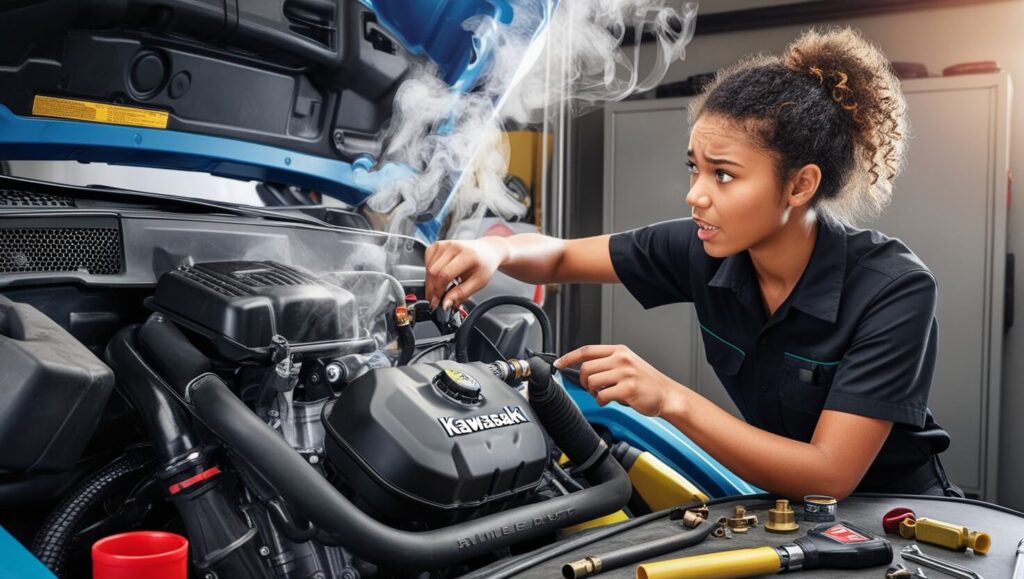
There are several reasons why your KRX 1000 engine might overheat.
One common cause is insufficient coolant levels. If your coolant is low, it means your engine isn’t being cooled effectively.
Another reason could be a blocked radiator. Dirt and debris can clog the radiator fins, preventing airflow and causing the engine temperature to rise.
Additionally, a faulty thermostat can disrupt the coolant flow, leading to overheating.
Recognizing the Symptoms
Recognizing the symptoms of engine overheating is crucial to preventing serious damage.
If you notice the temperature gauge rising higher than normal, or if you experience steam coming from under the hood, these are clear signs that something’s wrong.
Other symptoms may include a loud noise from the engine or a sudden decrease in power while driving. Personally, I once ignored the warning signs, and it led to a costly repair!
Solutions
To solve overheating issues, start by checking and topping off your coolant levels.
Regularly inspect the radiator for blockages or dirt and clean it to ensure proper airflow. If the thermostat seems faulty, replacing it can often resolve these overheating problems.
Finally, make sure to take your KRX 1000 for regular maintenance.
By taking these simple steps, you can help ensure your engine runs smoothly and efficiently, preventing overheating in the future.
10. Kawasaki KRX 1000 Engine Knocking Issues
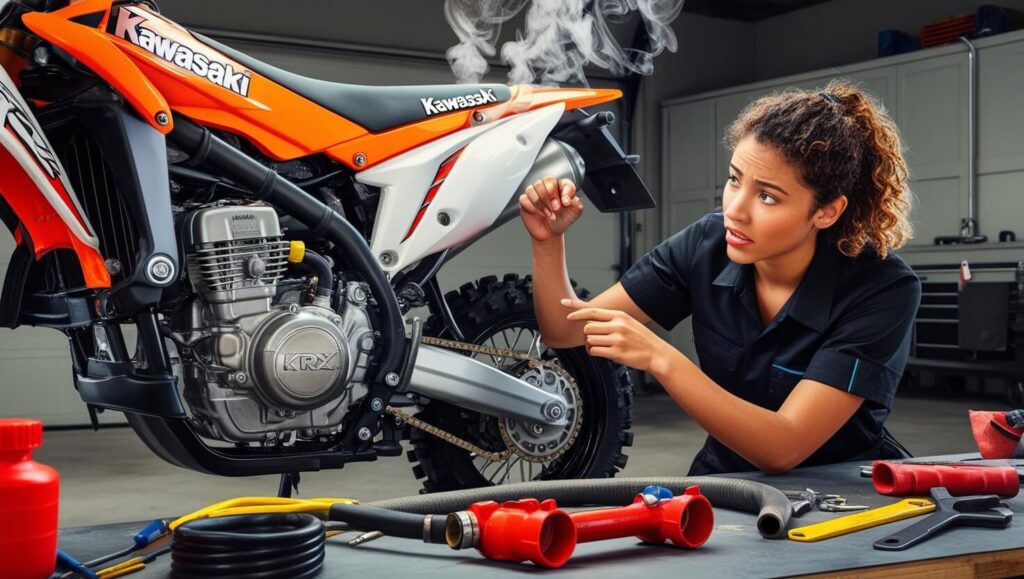
There are various reasons why you might experience engine knocking in your Kawasaki KRX 1000.
One common cause is poor fuel quality. Using lower octane fuel can lead to pre-ignition, resulting in knocking sounds.
Other potential causes include worn-out engine components or incorrect timing. If you hear knocking when accelerating, it’s essential to investigate further.
Remember, diagnosing this problem early can save you from extensive damage.
Symptoms and Solutions to Look For
Listening for the symptoms is crucial. You may notice a rattling or knocking sound from the engine when you accelerate or under heavy load conditions.
Although this might alarm you, don’t panic just yet! First, ensure you’re using the right octane fuel recommended by the manufacturer.
If the knocking persists, it might be time to check the spark plugs or schedule a visit to your mechanic for a thorough inspection.
To prevent these issues, regular maintenance is key. Keeping your engine oil at the recommended levels and changing it regularly can also help reduce knocking noises.
In my personal experience with the Kawasaki KRX 1000, I found that routine checks and using quality fuel made a significant difference.
If you face this problem, don’t hesitate to take action—it’s better to address potential problems sooner than later!
11. Engine Misfire
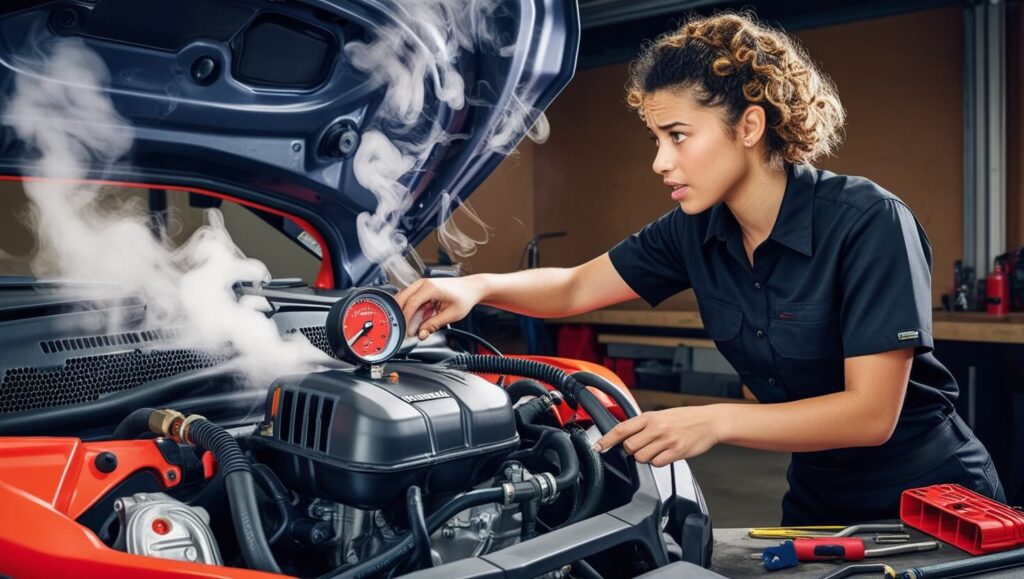
If you’ve been driving your Kawasaki KRX 1000 and noticed it acting unusually, such as stumbling or hesitating during acceleration, you might be experiencing an engine misfire.
Additionally, you may observe a check engine light illuminating on your dashboard. These symptoms are often signs of misfiring.
Common Causes of Engine Misfire
There are several reasons why your KRX 1000 may misfire.
These include faulty spark plugs or ignition coils, which are essential for ensuring an efficient combustion process.
Fuel delivery issues, such as clogged fuel injectors or a dirty fuel filter, can also play a significant role.
Solutions
To address these issues effectively, start with a thorough inspection of your spark plugs and ignition coils.
Replacing worn-out spark plugs can greatly enhance engine performance and eliminate misfires. If your fuel system is the culprit, consider cleaning or replacing fuel injectors and changing the fuel filter.
I recommend consulting with a trusted mechanic for a diagnostic check if the problem persists. Remember, regular maintenance is crucial to prevent misfire problems in the future.
Taking these proactive steps will not only extend the longevity of your Kawasaki KRX 1000 but also enhance your driving experience.
Kawasaki KRX 1000 Top Speed
By understanding the common Kawasaki KRX 1000 problems and their solutions, you can enjoy the thrill of your ATV while minimizing disruptions to your off-road adventures.
Whether you’re a seasoned rider or a newcomer to the world of ATVs, being proactive about maintenance and repair can significantly enhance your experience.